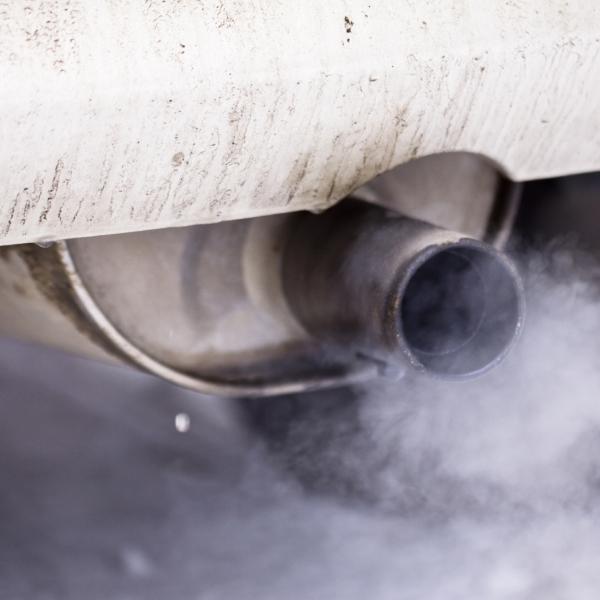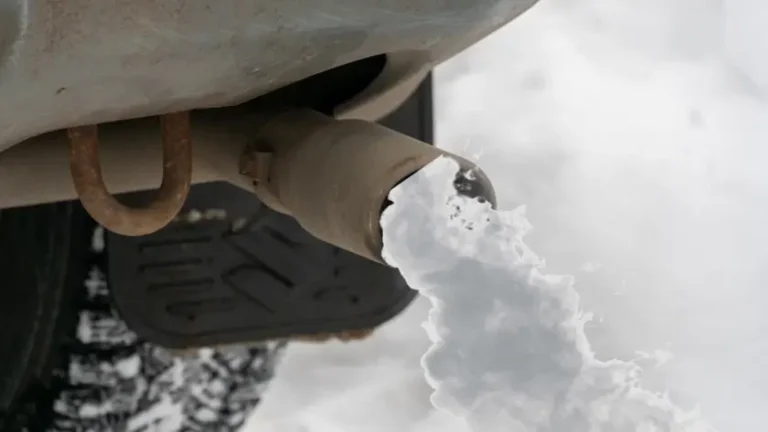No, white smoke does not always mean a blown head gasket. White smoke can come from various issues in your vehicle.
Understanding the cause is crucial. When white smoke billows from your car’s exhaust, it can be alarming. Many people jump to the conclusion that it’s a blown head gasket. While this is a common cause, it’s not the only one.
Other reasons for white smoke include condensation, coolant leaks, and issues with the fuel system. Knowing the exact cause can save you time and money on repairs.
In this blog post, we’ll explore the different reasons behind white smoke and help you determine whether it’s a serious problem or a minor issue. Stay tuned to learn more about your car’s health and how to address white smoke effectively.

Credit: www.reddit.com
Introduction To White Smoke In Vehicles
Seeing white smoke from your vehicle’s exhaust can be alarming. You might think it signals a serious problem. Many believe it means a blown head gasket.
But is that always the case? Understanding the causes can help you address the issue correctly.
Common Causes
Several factors can cause white smoke in vehicles. Knowing these can help you diagnose the problem accurately.
- Condensation: In cold weather, condensation can create white smoke. This usually disappears once the engine warms up.
- Coolant Leak: A small coolant leak can cause white smoke. This often smells sweet.
- Faulty Fuel Injectors: Fuel injectors that leak can cause white smoke. This is less common but still possible.
- Transmission Fluid: If transmission fluid leaks into the engine, white smoke may appear.
Initial Concerns
Your first concern should be to identify the smell of the white smoke. If it smells sweet, it could be a coolant leak. If it smells like fuel, check the fuel injectors. In either case, further investigation is needed.
Another concern is the amount of smoke. A lot of smoke might indicate a serious issue. A small amount may be less urgent but still needs attention.
Pay attention to your vehicle’s performance. Any changes in how it drives can give clues about the problem.

Credit: www.reddit.com
Understanding Head Gaskets
Understanding head gaskets is crucial for every car owner. These essential components play a vital role in your vehicle’s engine. Let’s dive into the function and importance of head gaskets and common failures they may face.
Function And Importance
The head gasket sits between the engine block and the cylinder head. It seals the internal combustion process. It also prevents coolant and oil from mixing. Here’s why this is important:
- Sealing the Combustion Chamber: This helps maintain engine power.
- Preventing Leakages: Stops oil and coolant from leaking into cylinders.
- Maintaining Pressure: Ensures efficient combustion by maintaining pressure.
If the head gasket fails, it can lead to several issues. Let’s explore typical failures of head gaskets.
Typical Failures
| Failure Type | Symptoms |
|---|---|
| Blown Head Gasket | White smoke, loss of power, coolant loss |
| Coolant Leak | Overheating, white exhaust smoke, bubbling in radiator |
| Oil Leak | Oil in coolant, blue exhaust smoke |
Failure of head gaskets can be costly. Recognizing the signs early can save you from bigger problems. Always keep an eye on unusual smoke, engine performance, and fluid levels. Early detection is key to preventing major engine damage.
White Smoke: Common Misconceptions
White smoke can cause concern for many car owners. It doesn’t always mean a blown head gasket. Other issues like condensation or coolant leaks might be the cause.
White smoke coming from your car’s exhaust can be alarming. Many people believe it always means a blown head gasket. This is a common misconception. While it can indicate a problem, it is not always the case. Understanding the true causes of white smoke can save you time and money.
Myths About White Smoke
Many drivers think white smoke only means a blown head gasket. This belief leads to unnecessary panic. In reality, there are other reasons for white smoke. It’s important to know the facts to avoid costly mistakes.
Some believe white smoke always means engine failure. This isn’t true. Not all white smoke signals a major issue. Sometimes, it’s just a minor problem that can be fixed easily.
Other Potential Causes
Condensation is a common cause of white smoke. This happens when water vapor in the exhaust system turns into steam. It’s normal and usually harmless, especially on cold mornings.
A leaking coolant can also cause white smoke. If coolant leaks into the engine, it creates white smoke. This is a sign of a coolant issue, not always a blown head gasket.
Another reason for white smoke is a problem with the fuel injector. A faulty injector can cause the engine to burn fuel improperly. This results in white smoke from the exhaust.
Understanding these common misconceptions helps you better diagnose car issues. Always consult a professional mechanic for accurate diagnostics.
“`
Diagnosing White Smoke Issues
White smoke from an exhaust doesn’t always mean a blown head gasket. Several factors can cause this issue, including condensation or fuel injector problems. Proper diagnosis is essential to pinpoint the exact cause.
White smoke from your vehicle’s exhaust can be alarming. It often leads to concerns about a blown head gasket. But white smoke does not always mean major engine trouble. Diagnosing the issue involves several steps. Let’s start with a visual inspection.
Visual Inspection
Begin by looking under the hood. Check the engine oil. Milky oil can indicate coolant mixing with the oil. This could mean a head gasket issue. Next, inspect the coolant. Low levels might suggest a leak. Also, look for any leaks around the engine.
Observe the exhaust. If white smoke appears only during startup, it might be condensation. Harmless water vapor can form in the exhaust on cold mornings. Persistent white smoke, though, needs further attention.
Professional Assessment
If the visual inspection raises concerns, seek a professional assessment. A mechanic can perform a compression test. This test checks for leaks in the head gasket. They might also use a chemical test. This detects exhaust gases in the coolant.
Professional tools and experience can pinpoint the problem. They might find a simpler issue, like a coolant leak or a bad sensor. Either way, a mechanic can provide a clear diagnosis.
Diagnosing white smoke issues is crucial. It ensures you address minor problems before they become major repairs.
“`
Symptoms Of A Blown Head Gasket
A blown head gasket can be a serious issue for your car’s engine. Recognizing the symptoms early can save you from expensive repairs. Here are some key signs to watch for.
Warning Signs
There are several warning signs that indicate a blown head gasket:
- White smoke from the exhaust: This is a common sign. It indicates coolant is burning in the engine.
- Overheating engine: Consistent overheating suggests the gasket is failing.
- Milky oil: Check your oil dipstick. If the oil looks milky, coolant might be leaking into it.
- Loss of coolant: If you are frequently topping off your coolant, it could be leaking internally.
- Rough idle: Engine misfires or runs rough due to compression loss.
Long-term Consequences
A blown head gasket has several long-term consequences for your vehicle:
- Engine damage: Continuous driving with a blown gasket can cause severe engine damage.
- Increased repair costs: Delaying repairs can lead to more expensive fixes.
- Reduced performance: A leaking gasket affects engine performance and efficiency.
- Potential breakdown: Ignoring the problem can lead to a complete breakdown.
Being aware of these symptoms can help you take timely action. This can prevent further damage and costly repairs.

Credit: motor.onehowto.com
Other Reasons For White Smoke
White smoke from your car exhaust can be alarming. Many assume it means a blown head gasket. But other issues may cause white smoke. Let’s explore some common causes.
Coolant Leaks
One major cause of white smoke is a coolant leak. When coolant enters the combustion chamber, it burns. This creates thick white smoke. To check for coolant leaks, look at the coolant level. If it’s dropping fast, there may be a leak. Also, check for puddles under the car.
Leaking coolant can come from many places:
- Radiator
- Water pump
- Heater core
- Hoses
Addressing a coolant leak early can save you from bigger repairs.
Condensation
Another common cause of white smoke is condensation. This is normal, especially on cold mornings. When you start your car, the exhaust system heats up. This burns off any water vapor, creating white smoke.
To tell if it’s just condensation:
- Check the weather. Is it cold or damp?
- Watch the smoke. Does it go away after the car warms up?
Condensation smoke is usually thin and disappears quickly.
Understanding these causes helps keep your car running smoothly. Regular maintenance and checks can prevent many issues. If you are unsure, consult a mechanic.
https://www.youtube.com/watch?v=ryqstpCuz_w
Preventive Measures
Preventive measures can help you avoid the headache of a blown head gasket. Regular maintenance and early detection are key to keeping your engine in top shape. Let’s dive into these preventive measures to ensure your car runs smoothly.
Regular Maintenance
Regular maintenance is essential for preventing serious engine problems. Here are some steps to keep your engine healthy:
- Check coolant levels: Low coolant can lead to overheating.
- Inspect hoses and belts: Look for wear and replace if necessary.
- Change oil regularly: Fresh oil keeps the engine lubricated and running smoothly.
- Monitor temperature gauge: High temperatures can indicate a potential issue.
Keeping up with these tasks can prevent white smoke and other engine issues.
Early Detection
Early detection of potential problems can save you from expensive repairs. Here’s what to watch for:
- White smoke from the exhaust: This can indicate coolant leaking into the engine.
- Overheating engine: An overheating engine can cause a blown head gasket.
- Milky oil: Check for a milky appearance on the dipstick, which suggests coolant contamination.
- Loss of coolant: Frequent refills may signal a leak in the system.
Identifying these signs early can prevent further damage to your engine.
Frequently Asked Questions
What Does White Smoke From Exhaust Indicate?
White smoke from the exhaust often indicates coolant is being burned in the engine. This can be a sign of a blown head gasket, which allows coolant to enter the combustion chamber.
Is White Smoke Always A Bad Sign?
White smoke is not always a bad sign, but it typically signals an issue. It can indicate a blown head gasket, but sometimes it’s just condensation burning off.
Can A Blown Head Gasket Cause Engine Damage?
Yes, a blown head gasket can cause significant engine damage. It can lead to overheating, loss of power, and even complete engine failure if not addressed promptly.
How Do I Know If My Head Gasket Is Blown?
Common signs of a blown head gasket include white smoke from the exhaust, engine overheating, and a milky substance in the oil. You may also notice a loss of coolant without visible leaks.
Conclusion
White smoke doesn’t always mean a blown head gasket. Other issues can cause it too. Check for coolant leaks or condensation. Regular maintenance helps prevent engine problems. Pay attention to your car’s behavior. Early detection saves money and stress. Consult a mechanic if unsure.
They can diagnose the issue accurately. Keep your vehicle in top shape. Drive safely and stay informed. Thanks for reading!


